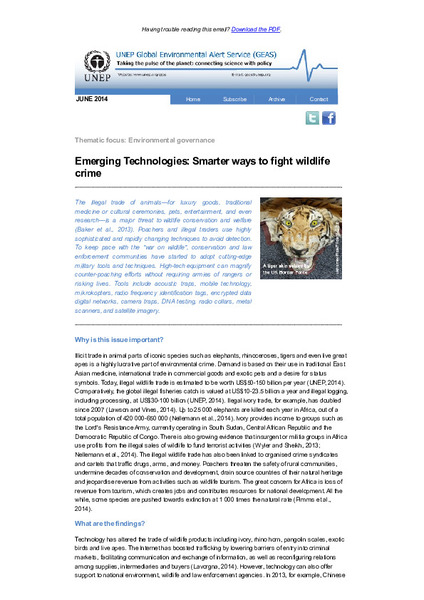Emerging Technologies: Smarter Ways to Fight Wildlife Crime - UNEP Global Environmental Alert Service (GEAS) June 2014
| dc.contributor | Science Division | en_US |
| dc.contributor.author | United Nations Environment Programme | en_US |
| dc.coverage.spatial | Global | en_US |
| dc.date.accessioned | 2022-10-24T08:54:11Z | |
| dc.date.available | 2022-10-24T08:54:11Z | |
| dc.date.issued | 2014-06 | |
| dc.identifier.uri | https://wedocs.unep.org/20.500.11822/40957 | |
| dc.description | The illegal trade of animals—for luxury goods, traditional medicine or cultural ceremonies, pets, entertainment, and even research—is a major threat to wildlife conservation and welfare (Baker et al., 2013). Poachers and illegal traders use highly sophisticated and rapidly changing techniques to avoid detection. To keep pace with the "war on wildlife", conservation and law enforcement communities have started to adopt cutting-edge military tools and techniques. High-tech equipment can magnify counter-poaching efforts without requiring armies of rangers or risking lives. Tools include acoustic traps, mobile technology, mikrokopters, radio frequency identification tags, encrypted data digital networks, camera traps, DNA testing, radio collars, metal scanners, and satellite imagery. | en_US |
| dc.format | Text | en_US |
| dc.language | English | en_US |
| dc.relation.ispartof | UNEP Global Environmental Alert Service (GEAS) | en_US |
| dc.rights | Public | en_US |
| dc.subject | wildlife conservation | en_US |
| dc.subject | animal trade | en_US |
| dc.subject | technology | en_US |
| dc.subject | wildlife protection | en_US |
| dc.subject | environmental crime | en_US |
| dc.title | Emerging Technologies: Smarter Ways to Fight Wildlife Crime - UNEP Global Environmental Alert Service (GEAS) June 2014 | en_US |


